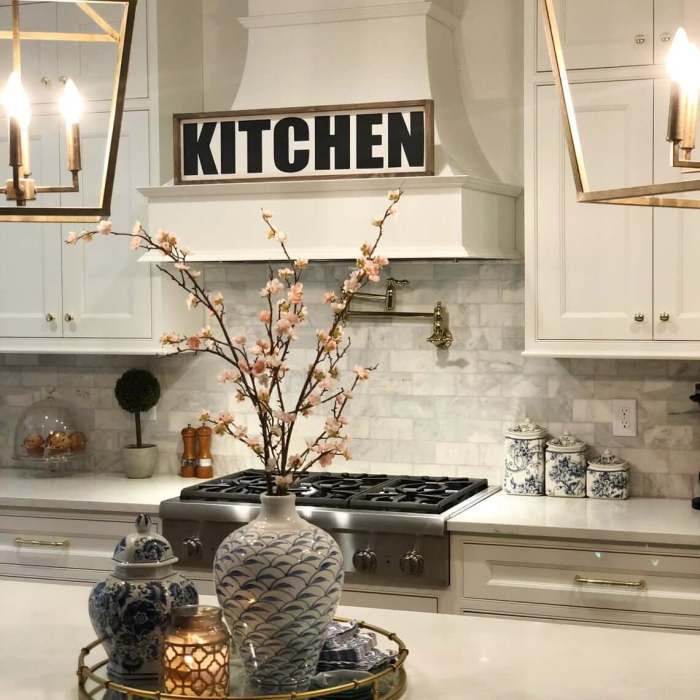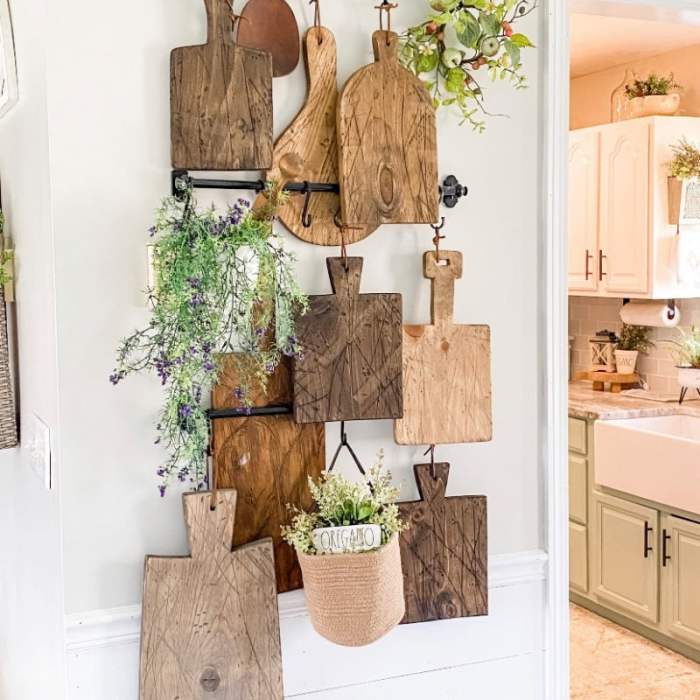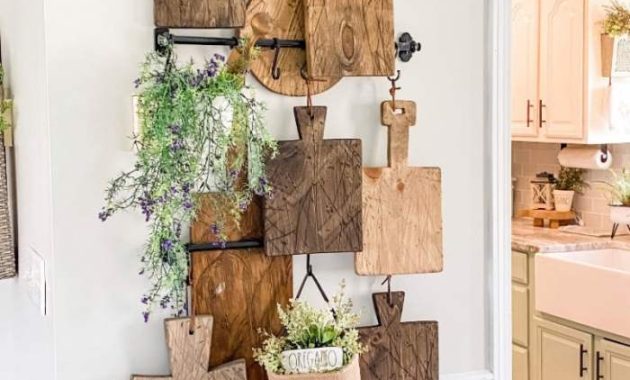Wall Colors & Paint Finishes

Kitchen decor for walls – The kitchen, that crucible of domesticity, where sustenance is born and stories simmer, deserves a considered approach to its aesthetic. The walls, silent witnesses to countless meals and whispered conversations, play a pivotal role in setting the tone. Choosing the right paint color and finish is not merely a decorative act; it’s an act of shaping the very atmosphere of the space, influencing mood and even appetite.
Trending Kitchen Wall Paint Colors and Their Psychological Impact
Color, in its potent silence, speaks volumes. The psychological impact of wall color in a kitchen is undeniable. Consider these five trending hues and their subtle yet powerful effects: Warm, earthy greiges offer a sense of calm and sophistication, mitigating the potential harshness of bright light. Deep, saturated blues evoke a sense of tranquility and spaciousness, ideal for smaller kitchens.
Soft, muted greens, reminiscent of verdant landscapes, bring a feeling of freshness and vitality. Subdued, sophisticated grays, like charcoal or slate, lend an air of contemporary elegance. Finally, creamy whites, always a classic, offer a blank canvas, allowing other elements in the kitchen to take center stage, creating a sense of brightness and cleanliness. These colors are not simply choices; they are carefully orchestrated notes in the symphony of the kitchen’s ambiance.
Comparison of Matte, Eggshell, Satin, and Semi-Gloss Paint Finishes
The sheen of a paint finish significantly alters the perception of a space. Matte finishes, with their velvety texture, absorb light, creating a warm, intimate feel, ideal for hiding imperfections but more prone to staining. Eggshell, with its subtle sheen, offers a balance between matte’s softness and the durability of glossier finishes. Satin, slightly glossier, is more resistant to scrubbing, making it a practical choice for high-traffic areas.
Semi-gloss, with its reflective surface, is the most durable and washable, perfect for areas prone to splashes and spills, but can highlight wall imperfections. The choice depends on the desired aesthetic and the level of practicality needed. Imagine a matte finish in a rustic farmhouse kitchen, offering a cozy, lived-in feel, contrasted with the crisp, clean semi-gloss in a modern, minimalist space, emphasizing its sleek lines.
Color Blocking Techniques for Visual Interest
Color blocking, a technique of using distinct blocks of color to create visual interest, can transform a kitchen from mundane to mesmerizing. Consider using a bold accent color on an island wall, contrasting with a neutral backdrop. Alternatively, create a striking feature wall using a vibrant hue, drawing the eye and adding a pop of personality. The key lies in careful consideration of color harmony and contrast.
For example, a deep teal accent wall paired with a creamy white background can create a sophisticated and visually appealing space. This technique allows for creative expression while maintaining a sense of balance and cohesion.
Color Palette for a Modern Farmhouse Kitchen
A modern farmhouse kitchen demands a palette that seamlessly blends rustic charm with contemporary elegance. The walls could be painted in a warm, creamy white, such as “Swiss Coffee” by Benjamin Moore, creating a bright and airy foundation. Accent colors could include a soft, muted blue-gray, like “Chelsea Gray” by Benjamin Moore, for cabinetry or backsplash, and touches of natural wood tones for warmth.
Black accents, used sparingly in hardware or light fixtures, could add a touch of modern sophistication. This palette balances the warmth of the farmhouse aesthetic with the clean lines of modern design, creating a harmonious and inviting space. The overall effect is one of relaxed sophistication, a space where comfort and style coexist in perfect harmony.
Revamping your kitchen? Wall decor sets the tone, from bold backsplashes to subtle artwork. But don’t forget the cabinets! Adding festive cheer is easy with creative christmas decor for kitchen cabinets , seamlessly blending seasonal spirit with your existing wall design. Ultimately, a cohesive look between walls and cabinets creates a truly inviting space.
Lighting & Wall Fixtures: Kitchen Decor For Walls

The heart of a home, the kitchen, demands illumination as nuanced and complex as the recipes it births. Lighting, far from a mere functional necessity, becomes a potent tool in shaping mood, highlighting textures, and ultimately, defining the very soul of the space. Its strategic deployment transcends mere brightness; it’s about orchestrating a symphony of light and shadow, a visual narrative that unfolds with every meal prepared, every conversation shared.
Types of Kitchen Lighting and Optimal Placement
Effective kitchen lighting necessitates a layered approach, combining task, ambient, and accent lighting to create a dynamic and functional environment. Task lighting, the workhorse of the kitchen, focuses intensely on specific areas requiring precise illumination, such as the countertop and sink. Ambient lighting provides a general, overall glow, setting the mood and illuminating the entire space. Accent lighting, in contrast, strategically highlights architectural details or decorative elements, adding depth and visual interest.
Imagine, for instance, a butcher block countertop brilliantly illuminated by under-cabinet lights, the overall warmth of the room established by recessed lights, and the gleam of a copper pot rack accentuated by strategically placed track lighting. This layered approach ensures every corner of the kitchen is both functional and visually appealing.
Incorporating Wall Sconces to Enhance Ambiance and Functionality
Wall sconces, often overlooked, offer a unique blend of form and function. Strategically placed flanking a range hood, they provide task lighting for the cooktop while simultaneously adding a touch of elegance. Consider sleek, minimalist sconces in a modern kitchen, or ornate, traditional fixtures in a more classical setting. Their vertical orientation contributes a unique dimension to the lighting scheme, offering a contrast to the horizontal lines of countertops and cabinets.
Moreover, sconces can be dimmed, allowing for a seamless transition from bright task lighting to a softer, more intimate ambiance for evening gatherings. Imagine the warm glow of softly lit sconces casting dancing shadows on the walls, creating an inviting atmosphere after a long day.
Comparison of Pendant Light Styles for Kitchen Islands or Peninsulas
Pendant lights reign supreme above kitchen islands and peninsulas, acting as both functional lighting and striking focal points. The choice of style significantly impacts the overall aesthetic. Linear pendants, with their sleek, minimalist designs, perfectly complement modern kitchens, offering a clean, uncluttered look. Conversely, globe pendants, with their softer, more diffused light, add a touch of vintage charm to traditional or farmhouse-style kitchens.
Finally, drum pendants, with their cylindrical shape, offer a versatile option suitable for a range of styles, providing a balance between contemporary and classic aesthetics. The size and number of pendants should be carefully considered to ensure adequate illumination without overwhelming the space. A large island might benefit from multiple pendants arranged in a visually appealing pattern, while a smaller peninsula might require only one statement piece.
Detailed Description of a Kitchen Lighting Scheme
This scheme integrates recessed lighting, pendant lights, and under-cabinet lighting to create a balanced and functional illumination plan. Recessed lights, strategically placed throughout the ceiling, provide the foundational ambient lighting, ensuring a consistently bright and evenly lit space. Three large drum pendants, suspended above a central island, offer focused task lighting and a striking visual centerpiece. Their warm, inviting glow complements the overall ambiance.
Finally, under-cabinet lighting, fitted beneath the wall cabinets, illuminates the countertop, providing crucial task lighting for food preparation and cleaning. This layering of light sources ensures every activity in the kitchen is adequately illuminated, while also contributing to the overall aesthetic appeal of the space. Imagine a simple diagram: The ceiling shows evenly spaced recessed lights. Below, a large island is depicted, with three drum pendants hanging centrally above it. Under the wall-mounted cabinets, a continuous line indicates the under-cabinet lighting. The arrangement clearly illustrates the layered approach, showing how each lighting type contributes to the overall illumination and functionality of the kitchen.
Wallpaper & Wall Coverings
The kitchen, that crucible of culinary creation and domestic drama, deserves a canvas as vibrant and multifaceted as the lives it nourishes. Beyond the mundane practicality of paint, lies the transformative power of wallpaper, a silent storyteller capable of weaving narratives across the very walls where meals are made and memories are forged. Its ability to instantly elevate a space, to introduce texture and personality, makes it a potent tool in the hands of a discerning kitchen designer.
Wallpaper’s capacity to redefine a space is particularly evident when employed to create a focal point. Imagine a breakfast nook, bathed in morning light, its walls adorned with a whimsical floral print, transforming a simple eating area into a charming and intimate retreat. Or consider a dining space, its grandeur underscored by a bold geometric pattern, setting a sophisticated tone for evening gatherings.
The strategic application of wallpaper can subtly yet powerfully shift the perceived atmosphere of the entire kitchen, from bustling work zone to tranquil haven.
Wallpaper in the Kitchen: Advantages and Disadvantages
The kitchen environment, with its inherent humidity and potential for spills, presents unique challenges for any wall covering. Therefore, a careful consideration of both the advantages and disadvantages of using wallpaper is paramount to ensure a successful and long-lasting result. The choice between durability and aesthetic appeal requires a delicate balancing act, a negotiation between the practical and the poetic.
- Advantages: Wallpaper offers unparalleled design flexibility, allowing for the creation of unique and personalized spaces. Its ability to add texture and visual interest far surpasses that of paint. Furthermore, high-quality, vinyl-coated wallpapers are surprisingly durable and easy to clean, making them suitable for even the busiest kitchens.
- Disadvantages: The installation process can be time-consuming and labor-intensive, requiring patience and precision. Moisture is a significant concern; certain types of wallpaper are susceptible to peeling or warping in humid environments. Repairing damaged sections can be difficult, sometimes necessitating the replacement of entire panels. The cost of high-quality, durable wallpaper can also be considerably higher than paint.
Wallpaper Patterns and Textures for Different Kitchen Styles
The versatility of wallpaper extends to its adaptability across diverse kitchen styles. The right pattern and texture can seamlessly integrate with, or boldly contrast against, the overall aesthetic, enhancing the space’s unique character. The selection process is a creative exploration, a journey through a world of visual possibilities.
- Modern Kitchens: Clean lines and geometric patterns in muted tones (think greys, whites, and blacks) create a sleek and sophisticated ambiance. A subtle textured wallpaper with a metallic sheen can add a touch of luxury.
- Rustic Kitchens: Natural wood textures, floral motifs, and distressed finishes evoke a sense of warmth and nostalgia. Consider a wallpaper mimicking aged brick or stone for a truly authentic feel.
- Traditional Kitchens: Damask patterns, intricate floral designs, and rich, jewel-toned colors create a classic and elegant atmosphere. A subtle embossed wallpaper can add depth and texture.
- Farmhouse Kitchens: Checkerboard patterns, gingham prints, and subtle floral designs in pastel shades evoke a sense of rustic charm and simplicity. A wallpaper with a slightly distressed finish can enhance the vintage aesthetic.
Wallpaper Installation in the Kitchen: A Practical Guide, Kitchen decor for walls
Applying wallpaper to a kitchen wall is not a task to be undertaken lightly. It requires meticulous preparation and a steady hand. The process, however, is rewarding, transforming a blank canvas into a statement piece. Success hinges on careful attention to detail, from initial surface preparation to the final smoothing strokes.
- Surface Preparation: Ensure the wall is clean, dry, and free of any imperfections. Fill any holes or cracks with spackle and sand smooth. Prime the wall with a high-quality primer designed for wallpaper application. This step is crucial for ensuring proper adhesion and preventing the wallpaper from peeling or bubbling.
- Measuring and Cutting: Accurately measure the wall and cut the wallpaper panels to the appropriate size, adding a few extra inches for trimming. Use a sharp utility knife and a metal straight edge for clean cuts.
- Application: Apply wallpaper paste to the back of the wallpaper panel, following the manufacturer’s instructions. Carefully align the panel with the wall and smooth out any air bubbles or wrinkles using a smoothing tool or a clean cloth. Overlap panels slightly, ensuring a seamless transition.
- Trimming and Finishing: Once the wallpaper is dry, carefully trim any excess using a sharp utility knife and a metal straight edge. Clean up any excess paste and allow the wallpaper to cure completely before placing any furniture or kitchenware against the wall.
Key Questions Answered
Can I use dark colors in a small kitchen?
Dark colors can work in small kitchens if used strategically. Focus the dark color on one wall as an accent, and keep the rest light and bright to avoid a cramped feel. Good lighting is crucial.
How do I clean different backsplash materials?
Cleaning methods vary by material. Tile is generally easy to clean with mild soap and water. Stone may require specialized cleaners. Always check the manufacturer’s recommendations.
What is the best type of paint for kitchen walls?
Semi-gloss or satin paints are best for kitchens due to their durability and easy cleanability. They resist moisture and are more resistant to scratches than matte finishes.
How do I choose the right size artwork for my kitchen wall?
Consider the size of the wall and surrounding furniture. A large piece of art can anchor a large wall, while smaller pieces can work well in smaller spaces or grouped together as a gallery wall. Avoid pieces that are too small and lost on the wall.

